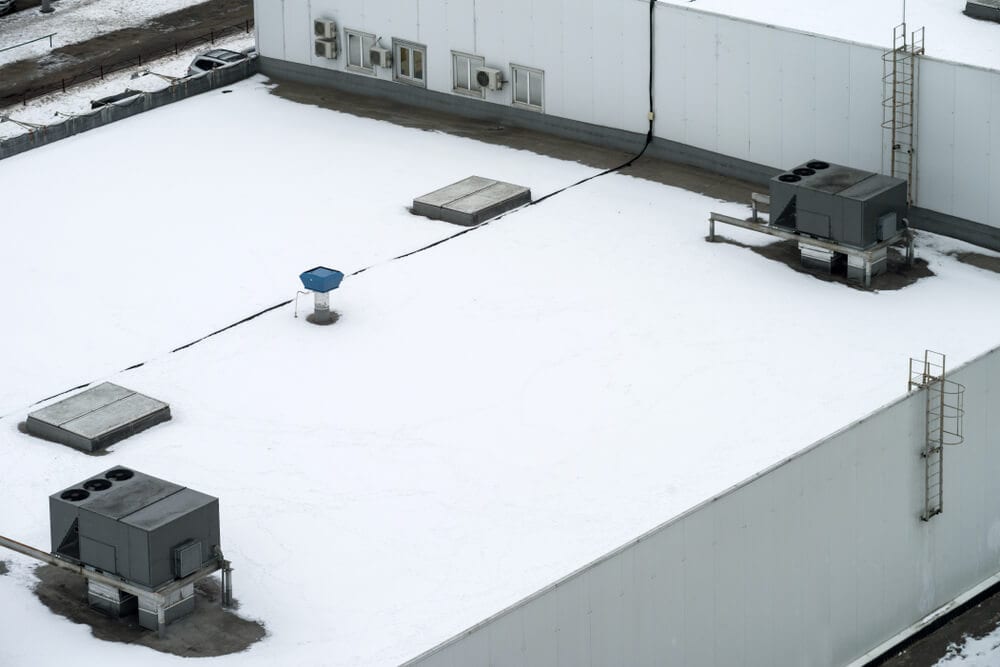Do you have to make a decision soon about a new commercial roof? Let’s take some time to discuss TPO vs PVC commercial roofing membranes. We’ll discuss the benefits of these single-ply roofing systems and the differences between the two types. We’ll also give you a general idea of the costs of each of these popular roof systems.
Contents
- 1 Benefits of TPO and PVC Roofing Systems
- 2 Differences Between TPO and PVC Roofing Materials
- 3 TPO Roofing or PVC Roofing? Which is Right for Your Commercial Buildings?
- 4 Key Takeaways About PVC Roof Membranes and TPO Membranes
- 4.0.0.1 Both TPO and PVC are single-ply, flexible roofing systems that boast watertight heat weldable seams.
- 4.0.0.2 TPO and PVC systems are chemical resistant, reflective of the sun’s ultraviolet rays, and can be mechanically attached, fully adhered, or self-adhered.
- 4.0.0.3 PVC is the older system. It offers excellent fire resistance and is less expensive than TPO membranes.
- 4.0.0.4 TPO is a stronger material than PVC.
- 4.0.0.5 A professional can help you decide if TPO, PVC, or another roofing option is suitable for your commercial building.
Benefits of TPO and PVC Roofing Systems
Both TPO and PVC are single-ply membranes made for low slope and flat roofs.
TPO (Thermoplastic Polyolefin) and PVC (Polyvinyl Chloride) are flexible membranes that conform to the shape and movement of the roof of your commercial building. Besides being flexible, both PVC roofs and TPO roofs are resistant to chemicals, grease, and oil – with PVC offering more chemical resistance.
Additionally, TPO and PVC membranes are light-colored, which makes them more resistant to UV radiation. This means that both the TPO and PVC membranes are environmentally friendly, allowing you to reduce your energy usage during the summer.
TPO and PVC are also lightweight and odorless. In addition, they feature watertight heat-welded seams and can be installed in several ways (mechanically fastened, fully adhered, and self-adhered.)
Differences Between TPO and PVC Roofing Materials
PVC is the older material. It has been used on commercial roofs since the 1960s. TPO was designed decades later from a combination of PVC and another rubber membrane called EPDM (Ethylene Propylene Diene Monomer.)
Even though TPO was formed later, there are benefits to the older PVC membrane, as PVC offers excellent fire resistance and is generally less expensive. However, TPO is a stronger roofing material with a higher tear and break strength.
TPO Roofing or PVC Roofing? Which is Right for Your Commercial Buildings?
Building owners trying to determine which roofing membrane would work best should contact AAA Roofing. AAA Roofing is one of the leading roofing companies in the Western U.S., having installed over 150 million square feet of roof surface.
AAA Roofing can handle all your commercial roofing needs, including roof replacement, new construction, roof repairs, and roof maintenance. If you have any questions about installing PVC or TPO roofing in San Jose, Riverside, Boise, or nearby areas in California and Idaho, contact us today. Our experts will help schedule an on-site consultation to explain each roofing system in detail and find the best fit for you.
Key Takeaways About PVC Roof Membranes and TPO Membranes
-
Both TPO and PVC are single-ply, flexible roofing systems that boast watertight heat weldable seams.
-
TPO and PVC systems are chemical resistant, reflective of the sun’s ultraviolet rays, and can be mechanically attached, fully adhered, or self-adhered.
-
PVC is the older system. It offers excellent fire resistance and is less expensive than TPO membranes.
-
TPO is a stronger material than PVC.
-
A professional can help you decide if TPO, PVC, or another roofing option is suitable for your commercial building.






